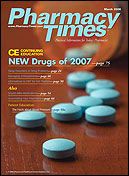Publication
Article
Pharmacy Times
Editor's Note: Are Intravenous Fluids Becoming a Commodity?
With the widespread use of the intravenous route in many settings, safeguards are needed.
Mr. McAllister is a health-systemsconsultant based in Chapel Hill,North Carolina.
Several excellent educationalsessions related to intravenous(IV) therapy were featured atthe American Society of Health-SystemPharmacists (ASHP) Midyear ClinicalMeeting in December, prompting me toreflect upon how much more diverse,sophisticated, and complicated IV therapyhas become during my career.
The IV route is used much more frequentlynow than it was 20 years ago,with virtually every hospitalized patientreceiving IV therapy at some point duringhis or her admission. Similarly, theIV route is increasingly used in theambulatory care environment and indiagnostic and procedure labs. I amtroubled, however, that pharmacy departmentsconsider IV solutions thathave not been compounded in theirpharmacy to be products for whichthey are not responsible.
A Changing Environment
Medical and technological advances,as well as market forces, havecontributed to the evolution of IV therapy.IV chemotherapy, which hasbecome much more sophisticated, isroutinely administered in ambulatorycare environments. New IV packagingextends well beyond a limited numberof intermittently administered antibioticsto include a broad array of basesolutions with electrolytes and otheradditives.
Certain intravenously administereddrugs are available exclusively throughspecialty pharmacy distributors overwhich pharmacy departments have littleor no control. Intelligentinfusion devices, which havebeen shown to reduce dosingerrors associated withIV infusions, include druglibraries with minimum/maximum dose-checkingfunctionality and monitoringcapabilities using wirelesstechnology. Hospitalsand their departments ofpharmacy have investedheavily in technologies thatare intended to improvevarious facets of the medicationuse process. Giventhese advancements, it isunderstandable that pharmacydepartments have prioritizedtheir resources tomaximize quality, efficiency, and cost-effectiveness.Distribution of IV basesolutions is often relegated to materialsmanagement or a similar department,and routine monitoring of use isreserved only for those patients whohave fluid and electrolyte challenges.
As a result, we largely ignore IV solutionswithout additives as a commodityfor which we have little responsibility.In some hospitals, pharmacy departmentshave allowed IV solutions withpremixed electrolytes to be issued byother departments or purchased onstanding purchase requisitions by procedurelabs and other departments;administration is at their discretion, withoutoversight.
System Safeguards Essential
All IV drugs and solutions are deemedlegend drugs for good reason, not onlyby the FDA but also by the Joint Commissionon the Accreditation of HealthcareOrganizations and ASHP in theirstandards and guidelines. The IV routeof administration is implicated in fartoo many serious medication errors. Isuspect that the underreporting phenomenonis prevalent with this groupof drugs and the diverse environmentsin which they are used.
It is time for pharmacy to assumeresponsibility for all IV therapy in allenvironments. This does not mean thatall IV fluids must be dispensed by thepharmacy department.We must designand implement system safeguards,however, to ensure that these drugs areadministered safely and appropriately.IV solutions are medicines; they are notcommodities. We must not let thetrend of seeing them as such continueor proliferate. What do you think?







